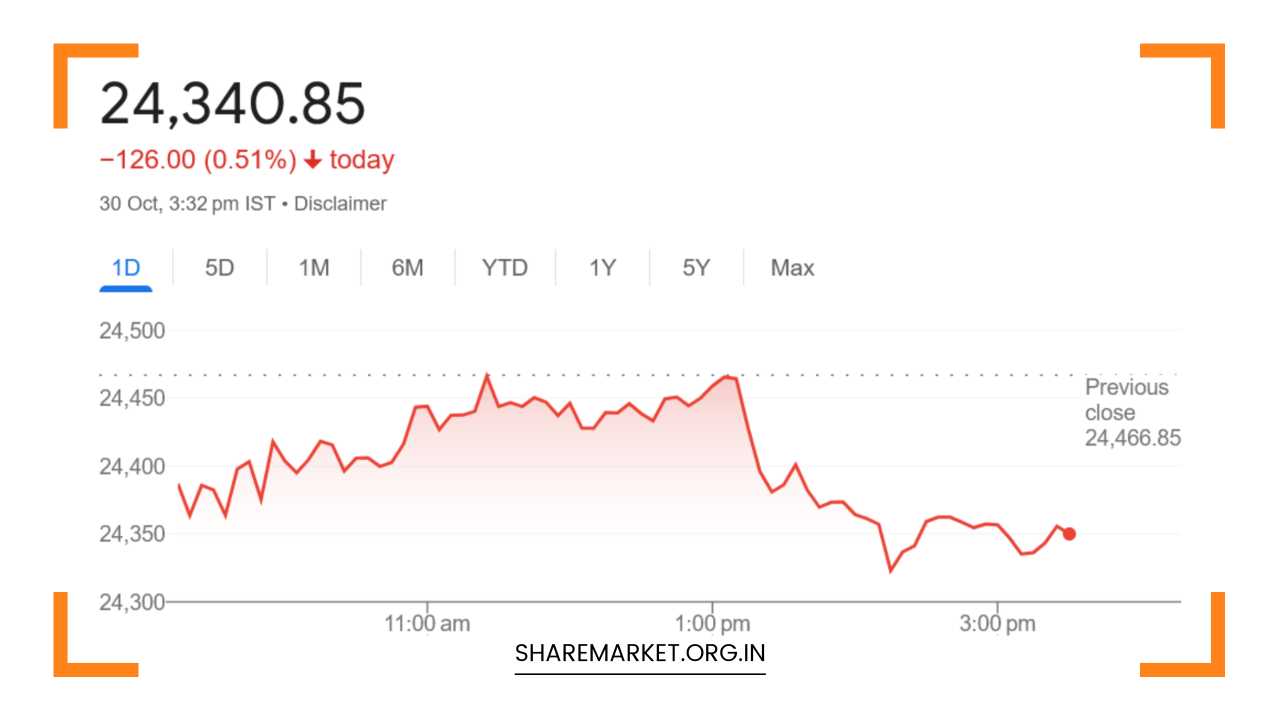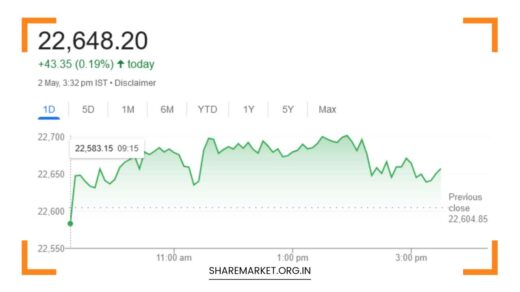Nifty Closed Below 24350; Tomorrow Nifty Prediction

Tomorrow Nifty Prediction
Nifty Closes Below 24,350: Market Prediction for October 31
On October 30, the Indian stock market faced a day of significant volatility, culminating in a decline for the Nifty Index, which closed at 24,340.80—a drop of 126 points or 0.51%.
This downturn is indicative of mixed investor sentiment and reflects broader economic uncertainties that have characterized recent trading sessions.
The Sensex mirrored this trend, closing at 79,942.18, down 426.85 points or 0.53%.
Throughout the trading day, market breadth displayed a diverse landscape, with 2,787 stocks registering gains, while 978 faced declines, and 79 remained unchanged.
Notable underperformers on the Nifty included prominent stocks such as Cipla, Shriram Finance, HDFC Life, Trent, and SBI Life Insurance, which suffered the largest losses.
On the flip side, Adani Enterprises, Tata Consumer Products, Hero MotoCorp, Britannia Industries, and Maruti Suzuki emerged as the day’s top gainers, showcasing pockets of resilience amid the overall market downturn.
Sectoral performance further highlighted the mixed signals within the market. The Fast-Moving Consumer Goods (FMCG), Capital Goods, and Media sectors reported gains ranging from 0.5% to 2%, signaling strength in these areas despite the overarching bearish trend.
Conversely, the Banking, Pharma, and IT sectors experienced declines of approximately 1% each, reflecting ongoing challenges faced by these critical segments.
The BSE Midcap index remained largely flat, while the Smallcap index outperformed, gaining 1.5% and demonstrating the resilience of smaller companies in a turbulent market environment.
Market Dynamics and Insights
Aditya Gaggar, Director at Progressive Shares, provided insights into the day’s trading dynamics. He observed that the Indian stock market opened sluggishly at 24,370, reflecting the cautious approach taken by investors.
Although the broader market displayed initial strength, allowing for a brief recovery, gains proved fleeting.
The Nifty’s inability to sustain upward momentum resulted in a lower close, reinforcing the prevailing uncertainty.
From a technical perspective, the Nifty continued to fluctuate within a defined range, with resistance identified at 24,480 and support shifting upwards to 24,200.
The formation of an ascending triangle on the charts suggests a potential breakout scenario. If the Nifty can decisively breach the resistance level at 24,480, it may pave the way for a bullish rally toward the target of 24,880.
Conversely, a failure to maintain support at 24,200 could lead to a decline towards the psychological support level of 24,000—a critical threshold that traders will closely monitor.
Ajit Mishra of Religare Broking echoed similar sentiments, noting the volatile nature of the market on October 30.
He pointed out that the Nifty has struggled to break past the resistance level of 24,500 over the past three trading sessions, which indicates that large-cap stocks are experiencing a mixed performance.
This resistance has become a focal point for traders, and the market’s trajectory may largely depend on whether it can break through this barrier.
Mishra emphasized the importance of adopting a cautious and defensive trading strategy in the current environment.
He suggested that traders focus on high-quality large-cap stocks within the Banking and IT sectors, as these may provide more stability amid the fluctuations.
A decisive breakout above 24,500 could signal a stronger upward momentum, while failure to do so may lead to prolonged consolidation and indecision in the market.
Broader Economic Context
The recent market movements cannot be viewed in isolation, as they are influenced by broader economic factors.
Global economic conditions, interest rate movements, and geopolitical tensions have created an atmosphere of uncertainty that permeates financial markets worldwide.
Investors are keenly observing cues from international markets, particularly the U.S. Federal Reserve’s stance on interest rates, as any shifts could significantly impact liquidity and risk appetite.
In addition to external factors, domestic economic indicators such as inflation rates, corporate earnings, and fiscal policies also play a crucial role in shaping market sentiment.
With inflation concerns remaining prominent, any unexpected data releases could further exacerbate volatility in the stock market.
Looking Ahead: Strategies for October 31
As we approach October 31, market participants should remain vigilant, closely monitoring the Nifty’s movements around the critical levels of 24,200 and 24,480. Here are some strategies and considerations for traders:
- Focus on Technical Indicators: Traders should utilize technical analysis tools to assess momentum and potential breakout points. Key indicators such as moving averages, Relative Strength Index (RSI), and Bollinger Bands can offer valuable insights into market trends.
- Sector Rotation: Given the mixed performance across sectors, it may be beneficial to adopt a sector rotation strategy. Identifying sectors showing strength, such as FMCG and Media, may present opportunities for investment.
- Diversification: To mitigate risk, traders should consider diversifying their portfolios. Allocating funds across various sectors and asset classes can provide a buffer against market volatility.
- Stay Informed: Keeping abreast of global economic news and domestic economic indicators will be essential in navigating the current market landscape. Timely information can aid in making informed trading decisions.
- Emotional Discipline: Given the current market conditions, maintaining emotional discipline is crucial. Traders should avoid making impulsive decisions based on short-term fluctuations and focus on long-term strategies.
In conclusion, the Indian stock market’s performance on October 30 highlights the complexities and challenges faced by investors.
As we move into October 31, understanding market dynamics, maintaining a defensive approach, and focusing on select large-cap stocks may provide a pathway to navigate these turbulent times.
The interplay between support and resistance levels will be critical in determining the market’s direction in the days ahead.

















